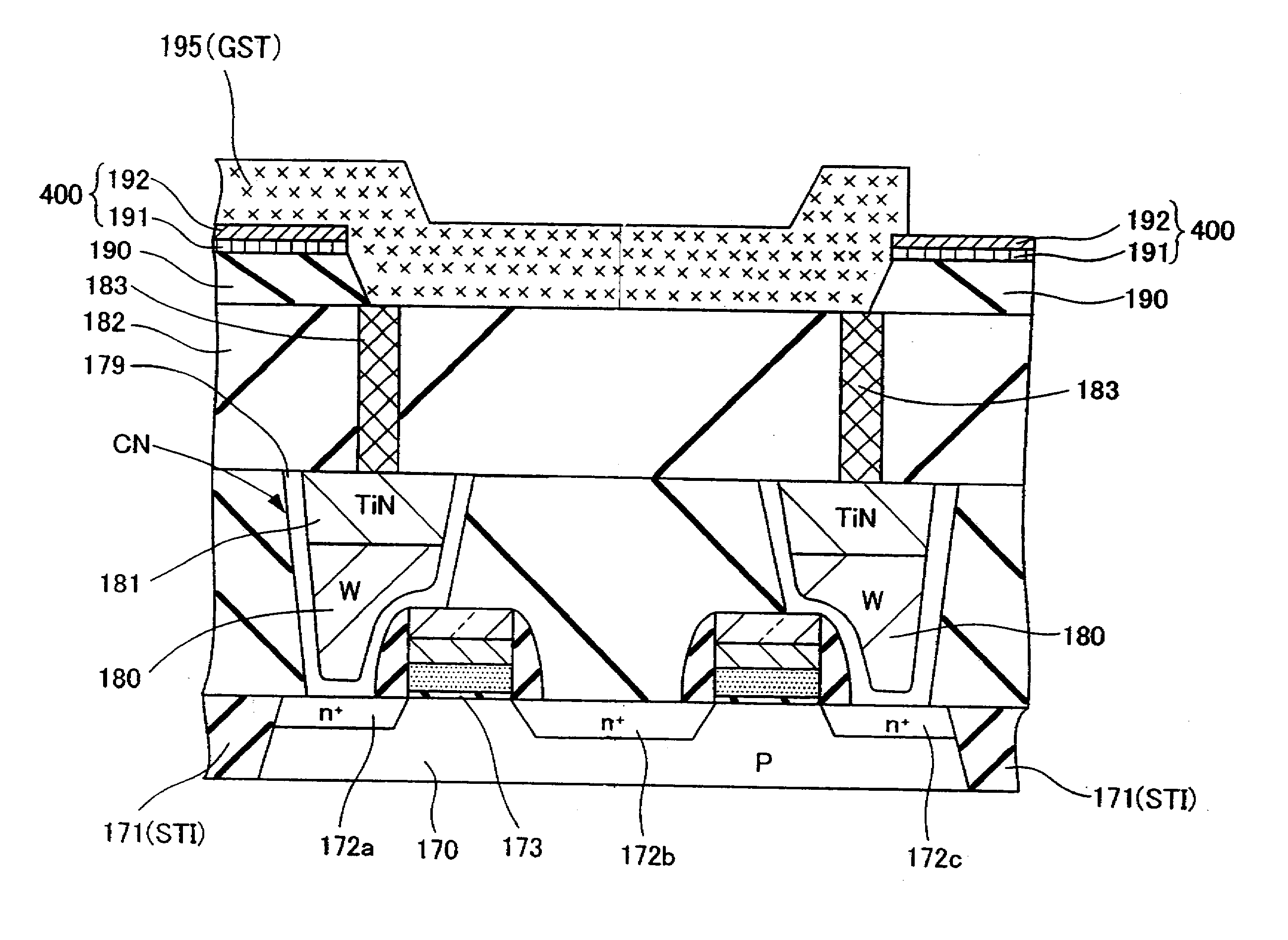Phase-change memory device with minimized reduction in thermal efficiency and method of manufacturing the same
a phase-change memory and thermal efficiency technology, applied in the field of phase-change memory devices, can solve the problems of large problem, complex method of manufacturing a phase-change memory device, and does not provide solutions to the above problems, so as to minimize the effect of thermal efficiency reduction
- Summary
- Abstract
- Description
- Claims
- Application Information
AI Technical Summary
Benefits of technology
Problems solved by technology
Method used
Image
Examples
1st embodiment
[0118]FIGS. 1A and 1B show a characteristic structure of a phase-change memory device according to the present invention. FIG. 1A shows an essential structure of the phase-change memory device according to the present invention, and FIG. 1B shows a conventional structure by which a heater electrode and a contact plug are connected to each other, as a comparative example.
[0119] As shown in FIG. 1A, an NMOS transistor (N-channel insulated-gate field effect transistor) M is a switching element for selecting a memory cell, and has a gate connected to word line WL1. The source of NMOS transistor M is connected to ground potential metal plug 100 made of material β and also to ground potential (reference potential) GND through ground potential interconnect 102 which is a ground interconnect made of material β.
[0120] The drain of NMOS transistor M is electrically connected to second electrically conductive material plug 108 of different-material contact plug 104.
[0121] Different-material...
2nd embodiment
[0137] In the second embodiment, different-material contact plug 104 shown in FIG. 1A will be considered with respect to various details below.
[0138] Preferred aspects of different-material contact plug 104 and their features are listed as follows:
[0139] (1) Different-material contact plug 104 is made up of first electrically conductive material plug 106 and second electrically conductive material plug 108. First electrically conductive material a of first electrically conductive material plug 106 and second electrically conductive material β of second electrically conductive material plug 108 are related to each other such that α>β with respect to the specific resistance and α<β with respect to the electrical conductivity and the thermal conductivity, as described above.
[0140] For example, if titanium (Ti: electrical conductivity of 1.34×104S / cm and thermal conductivity of 21.9 W / m·K) is used as first electrically conductive material α, then tungsten (W: electrical conductivity ...
3rd embodiment
[0162] In the present embodiment, the planar shape of a different-material contact plug, examples of materials used, and a method of manufacturing a different-material contact plug (and a ground potential plug) will be described below with reference to FIGS. 2 through 4D.
[0163]FIG. 2 shows planar configurations of a different-material contact plug and a ground potential plug and an essential cross-sectional structure of a phase-change memory device with those plugs. In FIG. 2, an upper section shows planar configurations of a different-material contact plug and a ground potential plug, a middle section shows a cross section of the device taken along line A-B of the upper section, and a lower section shows a cross section of the device taken along line A-C of the upper section.
[0164] Ground potential plug 100 and different-material contact plug 104 comprise respective TiN / Ti films 217a, 217b each having a lower thin titanium film and a titanium nitride film disposed thereon, made o...
PUM
 Login to View More
Login to View More Abstract
Description
Claims
Application Information
 Login to View More
Login to View More - R&D
- Intellectual Property
- Life Sciences
- Materials
- Tech Scout
- Unparalleled Data Quality
- Higher Quality Content
- 60% Fewer Hallucinations
Browse by: Latest US Patents, China's latest patents, Technical Efficacy Thesaurus, Application Domain, Technology Topic, Popular Technical Reports.
© 2025 PatSnap. All rights reserved.Legal|Privacy policy|Modern Slavery Act Transparency Statement|Sitemap|About US| Contact US: help@patsnap.com



